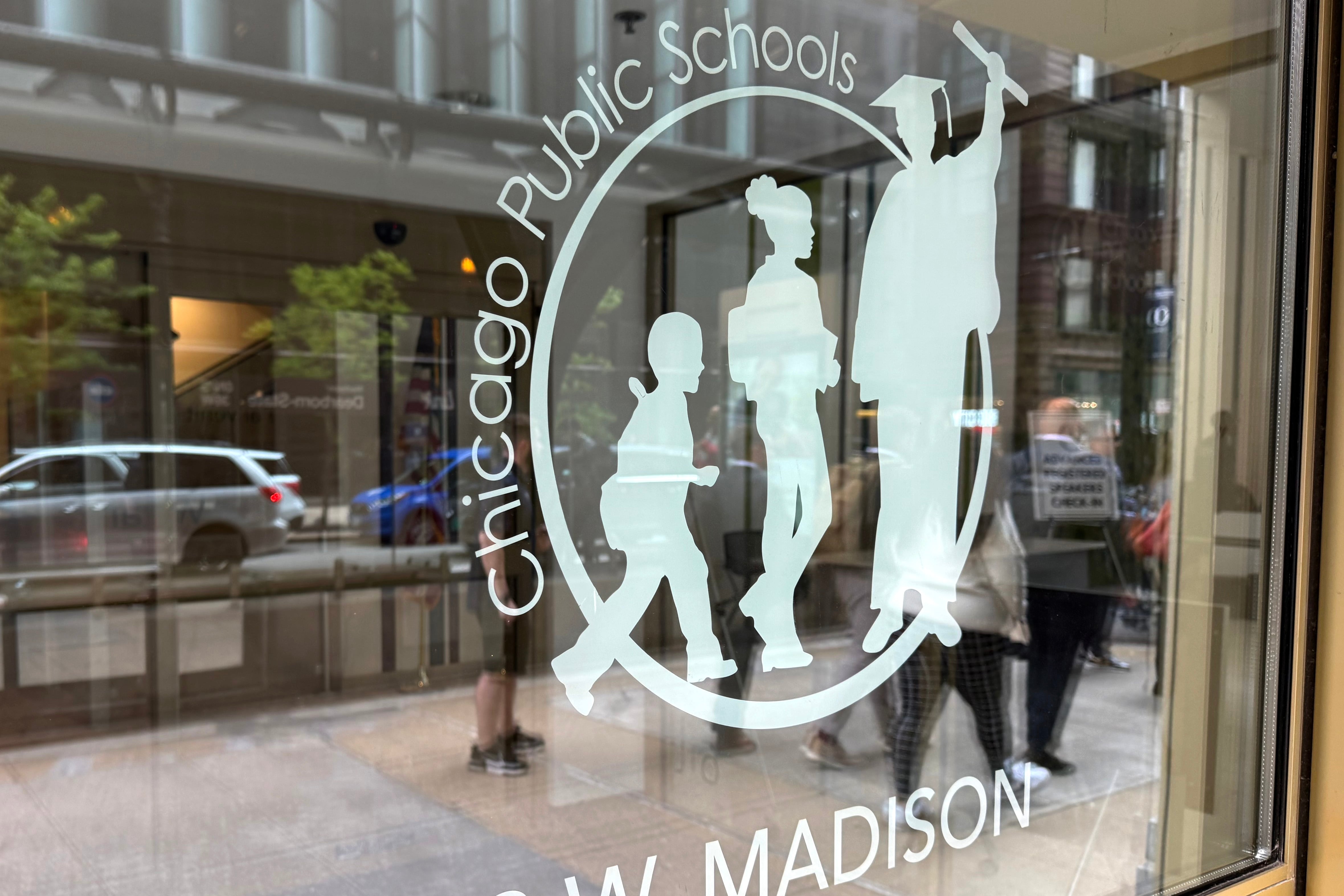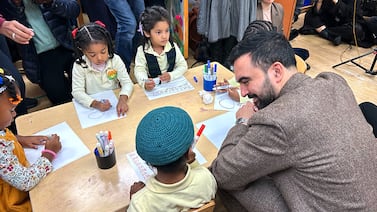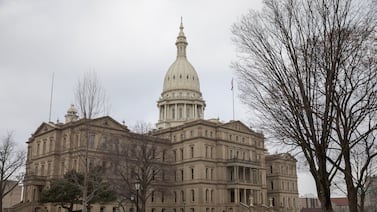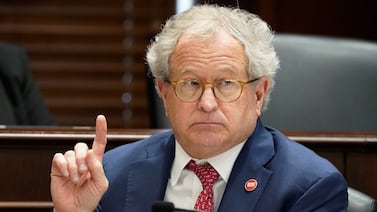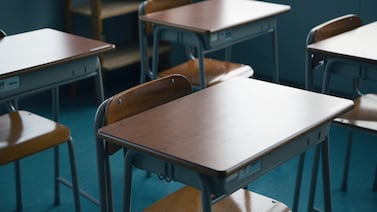Data analysis by Cherry Salazar.
Sign up for Chalkbeat Chicago’s free daily newsletter to keep up with the latest news on Chicago Public Schools.
Chicago Public Schools’ outstanding debt is roughly the same size as its annual budget: almost $10 billion. The district owes more per student than it spends per pupil in many of its schools.
Its massive obligations appear even more sobering compared with other cities.
Among the 25 largest school districts by student enrollment, CPS has the third-most outstanding debt, according to a Chalkbeat analysis of U.S. Census Bureau data for fiscal year 2023, the most recent available. That data shows CPS owes more than $28,000 per student, up from roughly $17,000 in 2013.
The debt burden for CPS has risen in recent years as it has fallen in some other large districts. It is also one of only three districts among the 25 largest where the debt has consistently exceeded annual revenue — a sign of financial instability, experts say.
City and school district leaders are fighting over whether CPS should borrow more to cover costs. The Chicago Board of Education is slated to vote on a spending plan later this week that limits new high-cost borrowing. But pressure is mounting from Mayor Brandon Johnson and his allies on the school board, who make up a majority, to leave open the option of taking out a short-term, high-interest loan to help cover a pension payment to the city and other costs.
Not all school district debt is created equal, experts stress: For districts with a growing enrollment and tax base, taking on debt to expand or modernize facilities makes sense. Many have voter-approved bonds that ensure a steady influx of dollars to pay off that debt.
But in Chicago’s case, CPS is spending hundreds of millions in state aid meant to educate students on paying off debt instead. At the same time, enrollment is falling, and its aging buildings are expected to cost billions to maintain in the coming years — projects that could lead to even more debt.
“It’s one thing to be highly leveraged when you are a growing district,” said Justin Marlowe, who leads the Center for Municipal Finance at the University of Chicago. “Sometimes, borrowing in that case is exactly the right thing to do. It’s a different story when your enrollment is flat or declining.”
Credit rating agencies are watching closely. Among the nation’s 25 largest school districts, CPS is the only one that has a junk bond rating from Moody’s. That means when it does borrow, the cost to pay back lenders is higher than it can be for other borrowers.
The district will spend roughly $1 billion to make debt payments this school year, or $264 million more than last year, according to the CPS budget proposal. CPS will use about $395 million in state revenue meant for teacher and staff salaries, textbooks, and more to pay off debt.
The mayor’s allies on the school board say borrowing is necessary to chip in for a municipal fund that covers CPS support staff pensions, maintain a cordial relationship with the city, and avoid budget cuts. But other board members and district leaders have countered that the payment will be too costly and place the district on shakier financial ground — a contention that several experts second.
Census data analyzed by Chalkbeat does not include CPS’s unfunded pension liabilities for its teacher pension fund. This year, those liabilities grew to $13.9 billion, and the CPS budget includes a more than $1 billion payment, about a third of it covered by the state.
Overall, experts say the district should continue work to improve its credit ratings, find additional revenues, and confront the massive needs of its aging buildings.
“There’s not an easy, fast ticket out,” said Daniel Vesecky of the Chicago-based think tank Civic Federation.
How did CPS end up in so much debt?
The district’s debt burden has swelled over the past two decades.
CPS has taken out bonds repeatedly to fix up aging buildings, including some it went on to close in past years and some operating at a fraction of their ideal capacity today.
In the years before the 2008 financial crash, district officials also engaged in risky borrowing in an effort to lower interest rates on existing debt that backfired when the economy collapsed, as reported by the Chicago Tribune.
And in the mid-2010s, at a time of intense financial strain before the state overhauled how it funded public education, Chicago’s school board did what officials today call “crisis borrowing” — much of it to pay for servicing its existing debt.
Experts said debt per student is generally a more accurate reflection of debt burden. But CPS officials cite a different metric of $2,970 in debt per Chicago resident. It has also steadily risen, but officials say it remains only slightly above the national average.
An influx in additional state revenue and federal COVID relief helped Chicago reduce its debt-to-revenue ratio from more than 150% in the mid-2010s to about 100% now. But anything more than 40% is a serious cause for concern, said Oliver Giesecke, a municipal finance expert at Stanford University.
Census data shows that the total amount of debt districts across the country has risen steadily and is more than double what it was two decades earlier. Still, Giesecke said the national housing boom and the growth in the property tax base helped stabilize many school districts’ and cities’ budgets since the Great Recession — but not in Chicago.
“Chicago’s housing market and overall economy has generally underperformed in those years compared to the national market,” he said.
Marguerite Roza of the Edunomics Lab at Georgetown University notes two districts that owe similar amounts can be on very different fiscal footing. CPS is dealing with enrollment declines and does not have a dedicated source of revenue to cover all of its debt service expenses. That’s different from growing districts where voters backed a large bond, she said: “These districts may be financially healthy — and that’s how you build a high school.”
Marlowe at the University of Chicago said another drawback is the relatively long amount of time Chicago is taking to pay off debt compared to other districts, in the name of getting fiscal breathing room now and spreading out the impact onto future budgets.
“The tradeoff is you pay a lot more in interest and fees and other costs unrelated to the district’s mission to educate students,” he said.
Good and bad debt in the CPS budget
This summer, Chicago school district officials put forward plans to issue $600 million in new debt for capital expenses. They also spelled out plans to refinance debt from that “crisis borrowing” a decade ago in order to realize about $129 million in savings. It would have saved significantly more if it had a better credit rating.
“We’re always fighting to get our credit ratings up,” said Wally Stock, CPS treasurer and deputy chief financial officer. “We’re still in the penalty box.”
Stock said the district has become more intentional in prioritizing critical building repairs and other projects to slow down the pace of borrowing. He noted the district has also seen some credit upgrades in recent years.
District officials say nearly $200 million of this year’s $1 billion debt service expenditures will go specifically to cover costs incurred during crisis borrowing in the mid-2010s. That could pay for at least 2,000 additional teachers instead.
Some think the state should play a larger role in covering the cost of maintaining and updating school buildings. Mary Filardo, executive director of the 21st Century School Fund, pointed out that while Illinois only covered a small portion of districts’ capital expenses. That’s left districts like CPS essentially to fend for themselves, and also fueled inequities between wealthier and poorer districts, she said.
Illinois “has been just delinquent on the capital side,” Filardo said.
Marlowe said closing and consolidating buildings, many of which are aging and were built to serve way more students than they do, would rein in additional debt — even though politically “that’s very challenging to do.”
Filardo opposes that approach, saying that closures tend to affect communities that are already disadvantaged. But in Chicago and elsewhere, district leaders are often reluctant to talk about this issue and engage communities in a search for solutions, she said.
“You have to admit you don’t know what to do and are willing to listen,” Filardo said.
Vesecky of the Civic Federation said the district should focus on making sound fiscal decisions in order to improve its credit rating and on building up its reserves. That would limit the need for short-term borrowing that the district is doing again this summer to meet payroll while awaiting delayed property tax revenue, costing more than $23 million. And it would drive down interest and other debt service costs and free up dollars to serve students.
Mila Koumpilova is Chalkbeat Chicago’s senior reporter covering Chicago Public Schools. Contact Mila at mkoumpilova@chalkbeat.org.

